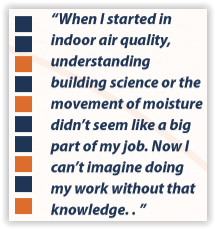Enlightening, Educational, Entertaining:
DISCOVERING HOW BUILDINGS FAIL
 Last month, I flew up to Boston to attend a conference I frequent each year: Building Science Summer Camp. I’ll be honest; this year’s BSSC wasn’t quite as educational as I expected, but they can’t all be home runs. I still had a great time, though. Each year, I go with a group of friends who are consultants like myself, or acquaintances I’ve met in other fields. Most of the lectures are enjoyable, and one of the most fun things we get to do at BSSC is see how buildings fail.
Last month, I flew up to Boston to attend a conference I frequent each year: Building Science Summer Camp. I’ll be honest; this year’s BSSC wasn’t quite as educational as I expected, but they can’t all be home runs. I still had a great time, though. Each year, I go with a group of friends who are consultants like myself, or acquaintances I’ve met in other fields. Most of the lectures are enjoyable, and one of the most fun things we get to do at BSSC is see how buildings fail.
Just over six years ago, Washington, D.C. experienced a major earthquake. Thankfully, no one died and few people were injured, but some of the nation’s iconic monuments suffered a great deal of damage. The Washington National Cathedral is still being repaired, with its bill clocking in at $34 million. Across the city, the Washington Monument suffered deep cracks. Described as a “singular disaster,” the Washington Monument was closed for three years during repairs.
Some time ago, the engineering firm that worked on the monument’s repairs gave a presentation at BSSC. This wasn’t an easy fix. The cracks let water inside, causing the building’s internal humidity to drastically increase. One of the engineers in the presentation talked about how she went to the top of the monument and squeezed through the tiny window. She then went down from the outside, checking the monument brick by brick to determine what needed to be done. The job took four people a week to complete.
They’re not all national monuments, of course, but some presentations can be just as interesting. Last year, a forensic carpenter gave a lecture explaining some of the misunderstandings about building science. His job is to go back into a building 10 years, five years, or sometimes just one year after construction is finished, and figure out where problems are coming from. Not understanding how moisture behaves or how to prevent it from moving into a building can cause all kinds of failures. The presentation was fascinating!
 When I started in indoor air quality, understanding building science or the movement of moisture didn’t seem like a big part of my job. Now I can’t imagine doing my work without that knowledge. I can better help my clients address the problems they face, and prevent future problems from arising, when I am able to recognize what causes these problems in the first place. Basically, I need to know why buildings fail so I can help my clients keep their buildings from going down the same path.
When I started in indoor air quality, understanding building science or the movement of moisture didn’t seem like a big part of my job. Now I can’t imagine doing my work without that knowledge. I can better help my clients address the problems they face, and prevent future problems from arising, when I am able to recognize what causes these problems in the first place. Basically, I need to know why buildings fail so I can help my clients keep their buildings from going down the same path.
Recently, I was in Albuquerque, New Mexico, to inspect the IAQ of a Social Security Administration building. They were worried about a mold problem, and in my report, I was able to include my findings, as well as notes on numerous small issues I saw. For instance, the caulking around the windows was old and could be letting in moisture; the air conditioning didn’t operate properly, and unfiltered air was being let into the building. All of these details came from my knowledge of building science, and only by correcting them could my client prevent additional problems in the future.
Even when Building Science Summer Camp doesn’t blow my socks off, you can bet I’ll be back next year. It’s a unique opportunity for education and enlightenment, and it’s guaranteed to be entertaining, too.

“
